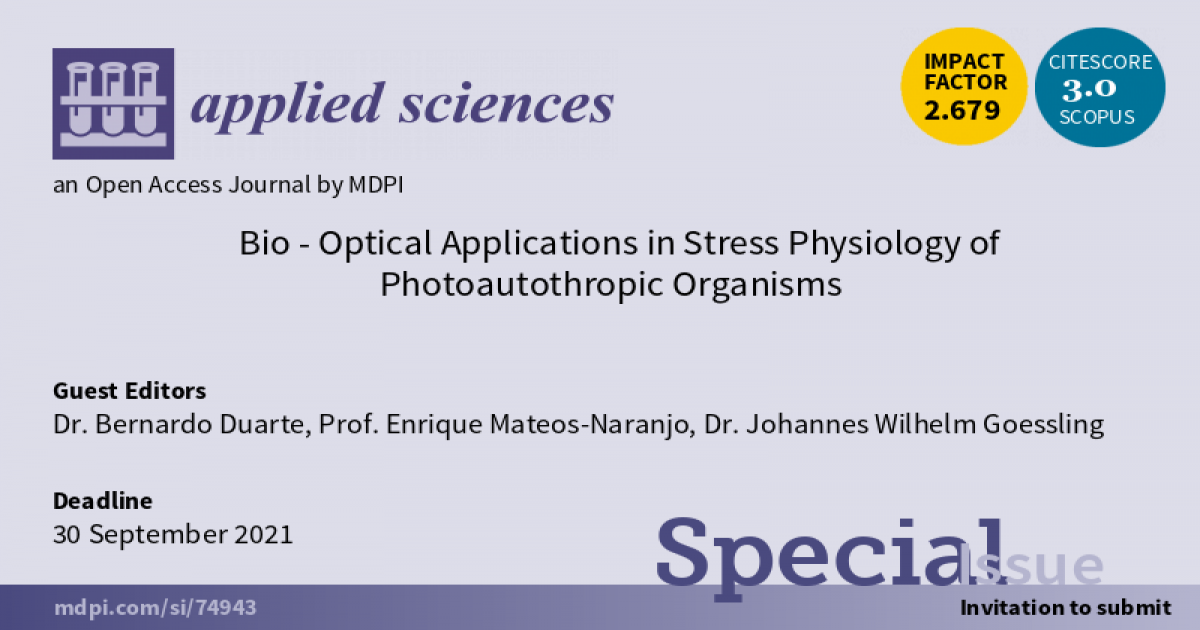Bio-Optical Applications in Stress Physiology of Photoautothropic Organisms
A special issue of Applied Sciences (ISSN 2076-3417). This special issue belongs to the section "Optics and Lasers".
Deadline for manuscript submissions: closed (30 September 2021) | Viewed by 979

Special Issue Editors
Interests: ecotoxicology; emerging and legacy contaminants; biomarker discovery; numeric tool development; toxicophenomics
Special Issues, Collections and Topics in MDPI journals
Interests: plant ecophysiology and abiotic factor synergies; conservation physiology; plant–microorganism interactions: applications in agriculture and environmental remediation
Interests: natural optical systems; photonic properties emerging from porous silicate exoskeletons of the diatoms; natural slab photonic crystals and their evolution in diatoms, as well as potential implications upon the organism
Special Issue Information
Dear Colleagues,
Photoautotrophic organisms provide a substantial amount of energy via primary production through their photosynthesis. Environmental factors interfere with photosynthesis at different stages if important resources are limited or exceeded. The intertwined relationship and feedback mechanisms connecting chemical regulation with light energy transfer at the photosystems facilitate detailed analysis of the physiological state of phototrophs based on non-invasive optical techniques. A variety of optical tools today available allow for quantification and imaging of photosynthetic activity at different scales, spanning from single chloroplasts, cells, and cultures, to large-scale primary production estimation with remote sensing technologies. Optical applications thus enable the study of photosynthesis and stress physiology from the molecular to the ecosystem level.
We would hereby cordially like to invite you to submit your paper to this Special Issue, comprising recent advances in bio-optical applications for analysis of physiological stress in photoautotrophic organisms. We are welcoming contributions focusing on the development of novel techniques, data analysis, and original research articles addressing stress physiology in phototrophs based on optical application measurements.
We would like to thank you very much for your time and consideration to contribute to this special issues.
With kind regards,
Dr. Bernardo Duarte
Prof. Enrique Mateos-Naranjo
Dr. Johannes Wilhelm Goessling
Guest Editors
Manuscript Submission Information
Manuscripts should be submitted online at www.mdpi.com by registering and logging in to this website. Once you are registered, click here to go to the submission form. Manuscripts can be submitted until the deadline. All submissions that pass pre-check are peer-reviewed. Accepted papers will be published continuously in the journal (as soon as accepted) and will be listed together on the special issue website. Research articles, review articles as well as short communications are invited. For planned papers, a title and short abstract (about 250 words) can be sent to the Editorial Office for assessment.
Submitted manuscripts should not have been published previously, nor be under consideration for publication elsewhere (except conference proceedings papers). All manuscripts are thoroughly refereed through a single-blind peer-review process. A guide for authors and other relevant information for submission of manuscripts is available on the Instructions for Authors page. Applied Sciences is an international peer-reviewed open access semimonthly journal published by MDPI.
Please visit the Instructions for Authors page before submitting a manuscript. The Article Processing Charge (APC) for publication in this open access journal is 2400 CHF (Swiss Francs). Submitted papers should be well formatted and use good English. Authors may use MDPI's English editing service prior to publication or during author revisions.
Keywords
- chlorophyll fluorescence analysis
- photopigments
- photosynthesis activity
- photosynthesis imaging
- plant stress physiology
- ecotoxicology
Benefits of Publishing in a Special Issue
- Ease of navigation: Grouping papers by topic helps scholars navigate broad scope journals more efficiently.
- Greater discoverability: Special Issues support the reach and impact of scientific research. Articles in Special Issues are more discoverable and cited more frequently.
- Expansion of research network: Special Issues facilitate connections among authors, fostering scientific collaborations.
- External promotion: Articles in Special Issues are often promoted through the journal's social media, increasing their visibility.
- Reprint: MDPI Books provides the opportunity to republish successful Special Issues in book format, both online and in print.
Further information on MDPI's Special Issue policies can be found here.







